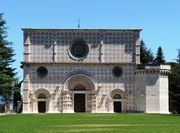Abruzzo
| Abruzzo | |||
|---|---|---|---|
| — Region of Italy — | |||
|
|||
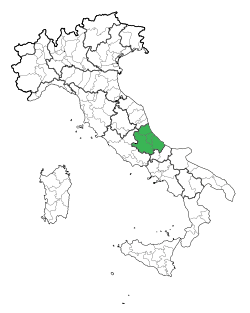 |
|||
| Country | Italy | ||
| Capital | L'Aquila | ||
| Government | |||
| - President | Giovanni Chiodi (PdL) | ||
| Area | |||
| - Total | 10,794 km2 (4,167.6 sq mi) | ||
| Population (2008-10-31) | |||
| - Total | 1,332,536 | ||
| - Density | 123.5/km2 (319.7/sq mi) | ||
| Time zone | CET (UTC+1) | ||
| - Summer (DST) | CEST (UTC+2) | ||
| GDP/ Nominal | € 26.8 billion (2006) | ||
| NUTS Region | ITF | ||
| Website | www.regione.abruzzo.it | ||
Abruzzo (pronounced [aˈbruttso]) is a region in Italy, its western border lying less than 50 miles due east of Rome. Abruzzo borders the region of Marche to the north, Lazio to the west and south-west, Molise to the south-east, and the Adriatic Sea to the east. Although geographically more of a central than southern region, ISTAT (the Italian statistical authority) considers it part of Southern Italy, a vestige of Abruzzo's historic association with the Kingdom of the Two Sicilies.
Contents |
Geography
The region is situated at the centre of the Italian peninsula facing the Adriatic, which it follows along 150 km of beaches and rocks. With an area of 10,794 km2 (4,168 sq mi), and bordered on the east by the Adriatic and on the west by the Apennines, it is one of the most mountainous regions in Italy (the Corno Grande in the Gran Sasso massif, at 2,914 m (9,560.37 ft), is the highest summit in the Apennines). The rivers, although numerous, are all seasonal except for the biggest - the Pescara and the Sangro. In the interior are the 500 km2 (190 sq mi) of the Abruzzo National Park, where rare examples of Mediterranean flora and fauna survive (chamois, wolves, bears, golden eagles).The climate is varied - warm and dry on the coast, an alpine climate in the mountainous interior. Major roads and railway lines link the region to the south, west and north of Italy and the rest of Europe.[1]
History
Humans have inhabited Abruzzo since Neolithic times. A skeleton from Lama dei Peligni in the province of Chieti has been radiometrically dated to 6,540 bp.[2] The name Abruzzo appears to derive from the Latin "Aprutium", although in Roman times the region was known at various times as Picenum, Sabina et Samnium, Flaminia et Picenum and/or Campania et Samnium.[3] This region was known as Aprutium in the Middle Ages arising from four possible sources. Many think it is apparently a corruption of Praetutium, or rather of the name of the people Praetutii, applied to their chief city, Interamnaes, now present day Teramo. Another etymology is from the Latin "aper" (boar) so that Aprutium was the "land of boars" or from "abruptum" (rugged, steep). A more recent etymology is from the Latin expression "a Bruttiis" (from the Bruttii) meaning the land that began from the Bruzi people, who moved south to occupy Calabria.[3][4]
Until 1963 it was part of the Abruzzi region with Molise. The term Abruzzi derives from the time when the region was part of the Kingdom of the Two Sicilies and the territory was administered as Abruzzo Citeriore (Nearer Abruzzo) and Abruzzo Ulteriore I and II (Farther Abruzzo I and II ), that being nearer and farther from Naples, the capital of the kingdom.[3] Abruzzo Citeriore is present day Chieti province. Abruzzo Ulteriore I comprised the Teramo and Pescara provinces; Abruzzo Ulteriore II is now the Province of L'Aquila. In this province is found the city of CORFINIO (known as CORFINIUM in ancient Italy), the chief city of the Paeligni, 7 m. N. of Sulmona in the valley of the Aternus. The site of the original town is occupied by the village of Pentima. It probably became subject to Rome in the 4th century B.C., though it does not appear in Roman history before the Social War (90 B.C.), in which it was at first adopted by the allies as the capital and seat of government of their newly founded state under the name Italia (this form, not Italica, is vouched for by the coins). It appears also as a fortress of importance in the Civil War, though it resisted Caesar's attack for a week (49 B.C.). The war was lost, but the name Italia remained to eventually be adopted by all of Italy. Entering Corfinio from the east, a plaque can be observed commemorating, and attributing the designation of the adopted name Italia to the peninsula by the Italic people of the region. These people were honored by Caesar as citizens of Rome.
Economy

Until a few decades ago, Abruzzo was a region of poverty in Southern Italy; over the past decades, however, it has developed to such an extent that it has escaped from the spiral of underdevelopment to become the 'first' region of the 'Italian Mezzogiorno'. This confirms its pivotal role in the national economic system. Since the 1950s, Abruzzo has had steady economic growth. In 1951, Abruzzo per capita income or GDP was 53% of that of Northern Italy, the nation's richest region. By 1971, Abruzzo was at 65% and, by 1994, per capita income was at 76% of Northern Italy's per capita income, giving Abruzzo the highest per capita GDP of Southern Italy and surpassing the growth rate of every other region of Italy. The construction of superhighways from Rome to Teramo (A24) and Rome to Pescara (A25) opened Abruzzo to easy access, state and private investment in the region increased, and Abruzzo attained higher per capita education levels and greater productivity growth than the rest of the South. As a result, Abruzzo's industrial sector expanded rapidly, especially in mechanical engineering, transportation equipment and telecommunications.[5] As of 2003, Abruzzo's per capita GDP was 19,506 EUR or 84% of the national average of 23,181 EUR and well outpacing that of the South (15,808 EUR).[6]
The structure of production in the region reflects the transformation of the economy from agriculture to industry and services. Agriculture, involving small holdings, has succeeded in modernising and offering high-quality products. The mostly small, agricultural holdings produce wine, cereals, sugar beet, potatoes, olives, vegetables, fruit and dairy products. Traditional products are saffron and liquorice. Although industry has developed strongly, it retains weak points due to the existence of only a few large businesses alongside a huge fabric of small and medium-sized businesses. Both pure and applied research are carried out in the region, where there are major institutes and factories involved in research in the fields of pharmaceutics, biomedicine, electronics, aerospace and nuclear physics. The industrial infrastructure is spread throughout the region in industrial zones which have already been mentioned, the most important of which are Val Pescara, Val Sangro, Val Trigno, Val Vibrata and Conca del Fucino. A further activity worthy of note is seaside and mountain tourism, which is of considerable importance to the economy of the region.[7]
Tourism and wildlife
.jpg)
In the past decade, tourism has increased, mostly among Italians and other Europeans. Abruzzo's wealth of castles and medieval towns, especially near the town of L'Aquila, has earned it in some quarters the nickname of "Abruzzoshire", by analogy with the "Chiantishire" nickname sometimes used to refer to the Chianti area of Tuscany, but Abruzzo is still off the beaten path for most visitors to Italy.
The region has 21 ski areas with 368 km. of runs, all within a few hours of Rome. The most developed resort being Roccaraso, followed by Campo Felice, and Campo Imperatore. Located in the highest region of the Apennines, these ski areas are at heights nearly comparable to many Alpine resorts. Because of their proximity to the Adriatic and winter precipitation patterns, they often have more snow than the Alps. Abruzzo also is popular for cross country skiing, especially on the high plain of Campo Imperatore in the Gran Sasso as well as the Piana Grande in the Majella.
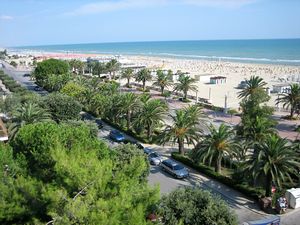
The Gran Sasso massif sports the Italian peninsula’s highest peak, Corno Grande, and Europe’s southernmost glacier, Il Calderone. The Corno Grande and its neighboring Corno Piccolo provide a range of climbing opportunities from mountain hikes suitable for novices to sheer rock wall ascents suitable only for expert alpinists. Abruzzo’s lesser known peaks, especially the gentler slopes of the Majella, offer climbers the opportunity to hike and climb in solitude.
Abruzzo’s 129 km. long sandy coastline is home to a many popular beach resorts, among them Vasto on Abruzzo’s southern coast; mid-coast are Silvi Marina, whose sands are considered among the best in Italy, Giulianova, Francavilla al Mare and Pineto, and on Abruzzo’s northern coast are Alba Adriatica and Martinsicuro.
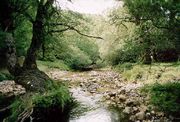
One third of the region is designated as national or regional parkland. The following parks lie, wholly or partially, within Abruzzo:
- Abruzzo National Park
- Gran Sasso e Monti della Laga National Park
- Majella National Park
- Sirente Velino Regional Park
- Lago di Barrea (Barrea Lake Wetlands)
The protected areas are environmentally important and are home to rare flora and fauna, such as the brown bear, the wolf and the chamois.
Demographics
| Historical populations | ||
|---|---|---|
| Year | Pop. | %± |
| 1861 | 858,000 | — |
| 1871 | 906,000 | 5.6% |
| 1881 | 946,000 | 4.4% |
| 1901 | 1,070,000 | 13.1% |
| 1911 | 1,116,000 | 4.3% |
| 1921 | 1,131,000 | 1.3% |
| 1931 | 1,168,000 | 3.3% |
| 1936 | 1,202,000 | 2.9% |
| 1951 | 1,277,000 | 6.2% |
| 1961 | 1,206,000 | −5.6% |
| 1971 | 1,167,000 | −3.2% |
| 1981 | 1,218,000 | 4.4% |
| 1991 | 1,249,000 | 2.5% |
| 2001 | 1,262,000 | 1.0% |
| 2008 (Est.) | 1,332,000 | 5.5% |
| Source: ISTAT 2001 | ||
The population density, although it has increased over the last decades, is well below the national average. In 2008 there were in fact 123.4 inhabitants per km2 in Abruzzo, compared to a national average of 198.8. At the province level, the situation is quite varied: Pescara is the most densely populated province (260.1 inhabitants per km2 in 2008), whereas, at the other extreme, L'Aquila is the least densely populated one (61.3 inhabitants per km2 in 2008), although it has the largest area. After decades of emigration from the region, the main feature of the 1980s is the immigration from third world countries. The population increase is due to the positive net migration, as since 1991 more deaths than births were registered in Abruzzo (except for 1999, when their number was equal).[8] In 2008 the Italian national institute of statistics ISTAT estimated that 59,749 foreign-born immigrants live in Abruzzo, equal to 4.5 % of the total regional population.
The most serious demographic imbalance is between the mountainous areas of the interior and the coastal strip. The largest province, L'Aquila, is situated entirely in the interior and has the lowest population density. The movement of the population of Abruzzo from the mountains to the sea has led to the almost complete urbanisation of the coastal strip. The effects on the interior have been impoverishment and a demographic ageing, reflected by an activity rate in the province of L'Aquila which is the lowest of the provinces in Abruzzo - accompanied by geological degradation as a result of the absence of conservation measures. In the coastal strip, on the other hand, there is such a jumble of accommodation and activities that the environment has been changed with negative effects. The policy of providing incentives for development has resulted in the setting-up of industrial zones, some of which (Vasto, Avezzano, Carsoli, Gissi, Val Vibrata, Val Sangro) have made genuine progress, while others (Val Pescara, L'Aquila) have run into trouble after initial success. The zones of Sulmona and Guardiagrele have turned out to be more or less failures. Outside these zones the main activities are agriculture and tourism.[8]
Major Cities
L'Aquila is both the capital city of the Abruzzo region and of the Province of L'Aquila and second largest city (pop. 73,000). L'Aquila was hit by an earthquake on 6 April 2009 which destroyed much of the city centre. The other provincial capitals are Pescara, which is Abruzzo's largest city and major port (pop. 123,000); Teramo (pop. 55,000) and Chieti (pop. 55,000). Other large municipalities in Abruzzo include Avezzano (pop.41,000), an industrial and high technology center, Lanciano (population 36,000), and Sulmona (population 25,000) are two important industrial and touristic centers.
Transport and mobility
Airports
Abruzzo International Airport is the only international airport in the region. Open to civilian traffic since 1996, has seen over the years more and more increase the number of transit passengers thanks to the airlines and low-cost flights. Today the airport has a catchment area of over 400,000 passengers annually and connects the city of Pescara and the entire region with many Italian and European destinations.
Airport Parks is located in the nearby village of Courts and was recently renovated and modernized to accommodate flights presidential G8, specifically moved into the city after the earthquake in the Abruzzi. Soon the airport will also be open to civilian traffic.
Ports
In Abruzzo are 4 main ports:

- Port of Pescara
- Port of Ortona
- Port Vast
- Port Giulianova
The Port of Pescara over the years has become one of the most important ports of Italy and the Adriatic Sea, over 60 years suffered 'a major restoration and was born like a modern marina which has moorings and facilities to shipbuilding 'vanguard. For some years been honored with the Blue flag 's European Union for the quality of services offered. Over the years the port of Pescara has lost its commercial vocation at the expense of passenger traffic, traffic that is growing approximately three years while maintaining a thriving market fishing and of 'aquaculture.
Rail services
Regarding rail transport, there is a significant disparity between the Abruzzo coast - modern art -and that of inland areas, very poor in terms of modernity and quality of service and waiting decades of development interventions and modernization (see in particular the Rome-Pescara line). For some routes it has reached the situation where road transport is much faster than rail, which sometimes have schedules similar to those of over a century ago, and that often leads people to use buses instead of trains.
Existing railway lines:
- Ferrovia Adriatica (through the whole of Italy from north to south, along the Adriatic Sea): The question that interests the Abruzzo region is included in the Towns of Martinsicuro and S. Unless, that delimit the borders with Marche and Molise regions, namely, the 113 km (70.21 mi) between the stations of intercurrent Alba Adriatica-Nereto-Controguerra and Broad-S. Salvo. The interchanges are made by the respective railway lines Giulianova Teramo and Pescara-Rome.
- Train Rome - Sulmona - Pescara Pescara-Rome railway line is along the railway line Bologna-Bari on the Adriatic other line is important because through the Tyrrhenian coast, passing through the provinces of Pescara, Chieti and L'Aquila and ends the path to Roma Tiburtina station. The railway which covers the Abruzzo Region, lies in 170 km (105.63 mi), ranging from municipalities to the province of Pescara Carsoli, and Oricola Pereto. The infrastructure in question is the following interchanges: Sulmona, Isernia, Terni-Sulmona, Avezzano-Roccasecca, Bologna and Bari.
- Sulmona - Carpinone: the infrastructure in question is a continuation to the south of Terni-Sulmona, as part of the intermediate cross-Pescara Naples. After that Brenner is the highest railway station in Italy, whose tortuous path, characterized by steep slopes, passing through the station Rivisondoli-Pescocostanzo and wedges in the Abruzzo National Park and the Maiella. The line is the interchanges of railway lines Rome-Pescara and Sulmona - L'Aquila - Rieti - Terni. Reached Carpinone, divides west to east to Benevento and Caserta.
- Sulmona - Terni: Trafficking in question connects the regions of Umbria, Lazio and Abruzzo, Molise and then along the line-Carpinone Sulmona. It therefore crosses the inner Abruzzo, finding interchanges Avezzano and Pescara-Rome-Roccasecca, in their respective provinces of L'Aquila, Terni and Rieti. It concerns a type of regional traffic in that, across the Tyrrhenian perpendicular colleague Abruzzo, Umbria, Lazio and Molise. The question of interest is included in the Abruzzo town of Sulmona and Tornimparte and more precisely in the stations 75 km (46.60 mi) intercurrent Sulmona and saddle horn.
- Avezzano railroad - Roccasecca: infrastructure test starts on the track in the town of Avezzano, crosses the territory of Marsica, passes through the valley and Bush get into the Lazio region, in the town of Sora. Her journey ends in the town of Roccasecca which marks the end of Lazio and the entry in the Campania region towards Cassino. Therefore the only online exchange that meets the railway line is Pescara - Rome station Avezzano.
- Giulianova - Teramo (a branch railway line Adriatic you forward towards the interior until Teramo) railway line Giulianova Teramo, the network is complementary to the Adriatic, fulfilling a liaison function between the capital and the coast. Therefore, the only rail interchange is characterized by the Adriatic railway line Bologna - Bari, Abruzzo is Martinsicuro rail-Broad-S. Salvo. With its 24 km (14.91 mi) journey infrastructure is the result, a SS80 along the path to the location of the industrial districts of Teramo, before merging the SS 16 that accesses the port Giulianova.
Sangritana (Lanciano - Castel di Sangro): The infrastructure in question are an important transition between the Tyrrhenian and Adriatic Seas, as in Pescara station meets the respective points of connection of the FS Bologna - Bari and Pescara - Rome, while that of Sulmona, L'Aquila lines FS - Terni and Sulmona - Carpinone. This position transition, attributed to the infrastructure an important strategic military role in World War II, a stage when the bombing of the German armed forces air, marked the temporary suspension of the subject line of repair work. Like other regional railways direct Aquila, Sulmona and Roccasecca, through a circuitous route mountain typically characterized by steep slopes, although in terms of localization of production facilities is to signal the passage of the railway in the industrial area of Valle del Sangro .
Highways
Overview of the route east of the tunnel just before the Great Sassola road and motorway network in the Abruzzo region is relatively well developed, there are three highways that serve the region:
- Highway A24 Roma - Aquila - Teramo, was built in the 70s and connects Rome with Lazio and more specifically to the Abruzzo Teramo via L'Aquila, performs an important liaison function of the region, both Tyrrhenian to the Adriatic, due to the presence of several knots of connection roads and highways. Numerous infrastructure connecting adjacent junction as directional Torano it branches in the A25 to Pescara, Teramo to Giulianova on SS80, SS81 to Chieti and on the A14 Bologna-Taranto, exit on the freeway Rieti Valley Jump -Terni, exit west on SS80 to L'Aquila Teramo, near Tivoli and the connection to the A1 motorway allows easy connections with Naples and Milan, the highway construction has contributed greatly to the economic development of the region .
- Highway A25 Torano - Avezzano - Pescara allows the connection between Rome and Pescara, as of the release of Torano begins its journey where it intersects with the A24, flows in the Conca Fucino exceeds the Appennino Abruzzese coming to Peligna Valley and ends at 'exit Pescara-Villanova to join the A14.
- Motorway A14 Bologna - Taranto said the A14 "Adriatica" includes 743 km (461.68 mi) of route, including the cities of Bologna and Taranto. Inaugurated in 1965 is now a major tourist infrastructure, as through the coastal towns of Emilia Romagna, Marche, Abruzzo, Molise and Puglia. Abruzzo is the infrastructure in question, including the toll of South Broad and Val Vibrata, which mark the border with the Marche and Molise. Regarding the links, the A14 meets the SS16 (which was necessarily walked before his execution), the SS652 Bottom Sangro Valley near Broad and SS80 in Giulianova.
Government and politics
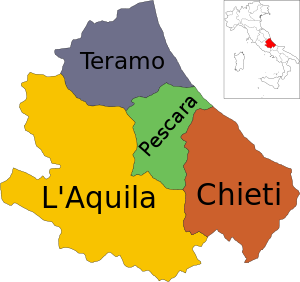
Administrative divisions
The region is divided into 4 provinces:
| Province | Area (km²) | Population | Density (inh./km²) |
|---|---|---|---|
| Province of Chieti | 2,588 | 396,190 | 153.1 |
| Province of L'Aquila | 5,034 | 308,876 | 61.3 |
| Province of Pescara | 1,225 | 318,701 | 260.1 |
| Province of Teramo | 1,948 | 308,769 | 158.5 |
Culture
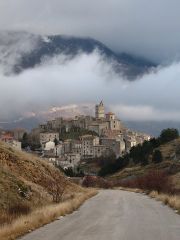
In the past, the region of Abruzzo was well known for the transumanza, the migratory movement of sheep principally south to the region of Puglia during the cold winter months.
The regional accents of Abruzzo include Teramano, Abruzzese Orientale Adriatico and Abruzzese Occidentale. The first two form part of the Italiano meridionale-interno dialect of southern Italy also known simply as "Neapolitan" due to the region having been part of the Kingdom of Naples and the Two Sicilies, while the Italian of L'Aquila Province is related to the Osco-Umbro dialect of central Italy, including the one of Rome. It should be noted that Abruzzo's Italian dialects are not particularly marked. In fact, Harvard University bases an intensive summer language program in Vasto, a resort town on Abruzzo's southern coast. There is, however, a small Albanian linguistic area at Penne, in the Province of Pescara.
Among Abruzzo many historic towns are: Sulmona at the foot of the Maiella massif and known for Italy’s most famous ancient poet , Ovid, Scanno, a lakeside hill town, Atri a picturesque artistic center, and the hillside towns of Penne, Lanciano and Loreto Aprutino.
Dialects
The dialects spoken in the Abruzzo region and can be divided into three main groups:
- Sabine dialect, in the province of L'Aquila (central Italian dialects)
- Abruzzo Adriatic dialectin the province of Teramo, Pescara and Chieti, that is virtually abandoned in the province of Ascoli Piceno (southern Italian dialects)
- Abruzzo western dialect, in the province of L'Aquila (southern Italian dialects)
Medieval and Renaissance hill towns
Abruzzo holds some of Italy's best-preserved medieval and Renaissance hill towns. The abrupt decline of Abruzzo’s agricultural economy in the early to mid-20th century saved some of the region’s most beautiful hill towns from the onslaught of modern development. Many lie entirely within regional and national parks so their preservation is all but guaranteed. Among the most well preserved are Castel del Monte and Santo Stefano di Sessanio, which lie in the Gran Sasso National Park on the edge of the high plain of Campo Imperatore and nestled beneath the Apennines’ highest peaks; both hill towns, which were ruled by the Medicis for over a century-and-a-half, have relatively little tourism. Between the two towns sits Rocca di Calascio, the ruin of an ancient fortress popular with film makers. Also within the Gran Sasso National Park is Castelli, an ancient pottery center whose artisans produced ceramics for most of the royal houses of Europe. Although still home to many artisans, Castelli has a modest tourist trade. Other medieval hill towns located fully within Abruzzo's park system are Pacentro in the Parco Nazionale della Majella and Pescasseroli in the Parco Nazionale d'Abruzzo. Pacentro, which features a 14th century castle with two intact towers, has been little touched by modernization.
Notes
- ↑ ABRUZZO - Geography and history Text finalised in March 2004 - Eurostat
- ↑ Journal of Anthropological Sciences, "Towards a re-appraisal of the Early Neolithic skeleton from Lama dei Peligni (Abruzzo, Italy" by Miliano Bruner and Giorgio Manzi, Vol. 81 (2003), pp. 69-78 (Abruzzo, Italy)
- ↑ 3.0 3.1 3.2 "WineCountry.it - Abruzzo wine region of Italy". winecountry.it. http://winecountry.it/regions/abruzzo/. Retrieved 2009-10-08.
- ↑ L'Abruzzo nel Tempo by Walfrido del Villano and Zopito di Tillio
- ↑ "“Abruzzo and Sicily: Catching up and lagging behind”, EIB Papers vol. 5, No. 1 (2000)" (PDF). http://www.eib.org/attachments/efs/eibpapers/eibpapers_2000_v05_n01/eibpapers_2000_v05_n01_a03_en.pdf. Retrieved 2010-04-22.
- ↑ Eurostat 2006
- ↑ "Eurostat". Circa.europa.eu. http://circa.europa.eu/irc/dsis/regportraits/info/data/en/itf1_eco.htm. Retrieved 2009-05-22.
- ↑ 8.0 8.1 "Eurostat". Circa.europa.eu. http://circa.europa.eu/irc/dsis/regportraits/info/data/en/index.htm. Retrieved 2009-05-22.
External links
- Official site of the regional administration
- Map of Abruzzo
- In the land of bears and castles, Financial Times, 29 June 2007
- Italy as it used to be The Guardian, 16 April 2005
- Life in Abruzzo,a chronicle of Abruzzo life written from a hill village in the Gran Sasso Mountains
- Italian lifestyle - pictures from Abruzzo
- Ski resorts in Abruzzo
- Abruzzo Travel Introduction VIDEO
- Abruzzo travel guide from Wikitravel
|
||||||||||
|
|||||||||||
|
||||||||||||||||||||||||||||||||||||||||||||||


